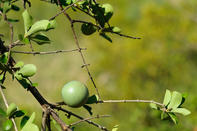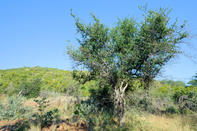
The potent poison strychnine is extracted from an Indian Strychnos species.
Black Monkey Orange Fruit
The black monkey orange bears a fruit about the same size as a commercial orange - up to 10 cm wide. This fruit starts out green-blue in colour and ripens to a dull yellow colour. Despite their size and thick rinds, the fruit is eaten by herbivores, such as kudu, eland, and nyala.
Baboons, monkeys, and bushpig will also eat the fruit, and manage them a little easier than the antelope. Due to their appeal to wildlife, humans who share the same habitat with wildlife will bury the monkey orange fruit until they are ripe and ready to eat.
Humans may eat the fruit fresh, only when ripe, or dry and powder it. It may be kept for weeks in its powder form. Drying the fruit with fire is supposed to improve the sweetness and for this task, silver cluster-leaf is the favoured wood. The shells of the fruit are used as sounders on traditional musical instruments or may be used as decorative calabashes and placed in fruit baskets in modern game lodges and homes.
The seeds have a purgative effect if ingested.
Black Monkey Orange Appearance

The leaves of the black monkey orange are variable in size. The distinguishing feature is the obvious 3-veins that originate from the base of the leaf. The side veins follow the margin of the leaf in parallel, almost to the apex.
The leaves are velvety in feel, shiny green on the upper side and born in clusters off knobbly side shoots which resemble spines but are not. The leaves are held close to the branches and don’t create a spreading canopy.
The presence of spines would probably indicate that the plant in question was, in fact, the similar green monkey-orange Strychnos spinosa. The stems grow very erect and appear bunched as if tied together by an imaginary rope.
Black Monkey Orange Fast Facts
Height - Usually 6 m (up to 15 m)
Growth form - Multi-stemmed with knobbly side-shoots and leaves tightly held against the branch
Leaf type - Simple
Leaf arrangement - Clustered
Leaf margin - Entire
Habitat - Open woodland and rocky areas
Deciduous or not - Deciduous
Most notable fruit/flowering season - Feb to Nov (Fruit)
By Megan Emmet